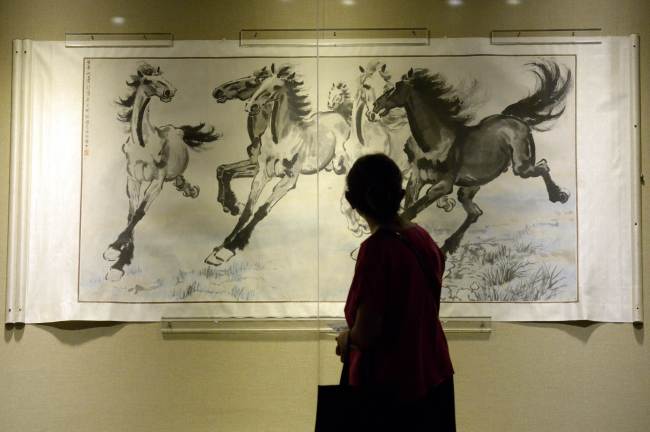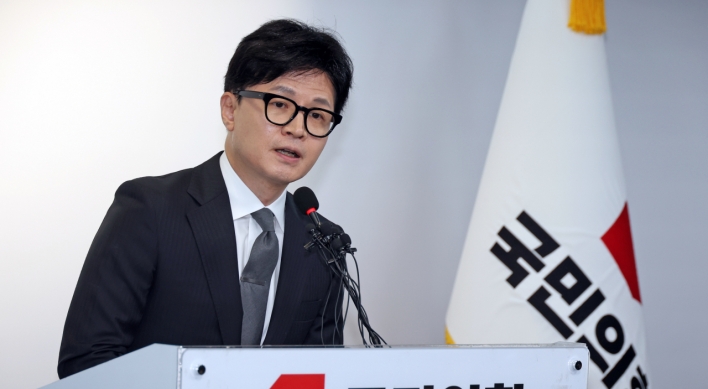BEIJING (AFP) ― Galloping with the vigor of strong and simple brush strokes, the horses painted by late Chinese master Xu Beihong inspired his countrymen in wartime ― and now they are lining up to pay huge sums to treasure them.
Xu, who died in 1953, created horses that pulsed with beauty and bravery just as China was struggling under Japanese occupation in the 1930s and 1940s, imbuing them with realism learned at the prestigious Ecole Nationale Superieure des Beaux-Arts in Paris.
His works have soared in desirability at the same time as his country’s leaders pursue a national renaissance and strike an aggressive posture in territorial disputes with Japan.
Xu, who died in 1953, created horses that pulsed with beauty and bravery just as China was struggling under Japanese occupation in the 1930s and 1940s, imbuing them with realism learned at the prestigious Ecole Nationale Superieure des Beaux-Arts in Paris.
His works have soared in desirability at the same time as his country’s leaders pursue a national renaissance and strike an aggressive posture in territorial disputes with Japan.

“He created his horses mainly during the War of Resistance (against Japan) and put all of his emotion into his paintings,” his son Xu Qingping told AFP.
“Horses are very beautiful, loyal, courageous and they always lead the charge to victory. I believe this is why Chinese people love his paintings.”
Having studied animal anatomy in Paris, Xu “came up with a special technique, using free brushstrokes, very few lines and only ink,” he said.
Among Xu’s hundreds of horses, the most sought-after are those racing ahead, hooves in the air. Those commanding the highest prices ― upward of $1 million ― are shown chest forward, head tossed to the side.
“The horses have expressive poses. Some are standing, some are galloping, or drinking water by the river,” said Carmen Ip, a specialist in Chinese art for auction house Sotheby’s.
“Under Xu’s strong brush strokes, they are muscular, lean and full of energy. He uses different shades of ink against white paper, creating light and shadow effect.”
French influences
Collectors also value the artwork for the inscriptions that Xu wrote on their foil edges.
They often contained a poem, such as those from the celebrated Tang dynasty (618-907) poet Du Fu, encouraging people not to give up, Ip said.
“This is especially meaningful during a time of political instability in China,” she said. “He was not only a great artist, he was also a passionate patriot.”
Several museums in China are dedicated to Xu, who became a father figure of Chinese painting and chaired the Central Academy of Fine Arts in Beijing.
An exhibition currently on in the Chinese capital, “A Master and His Masters,” displays 60 of his pictures along with 60 French works that influenced him.
The effects are most visible in his representations of the human body, an essential aspect of his training in Paris, said Philippe Cinquini, the show’s curator.
Chinese artists had virtually stopped depicting the body by the 19th century, whereas the tradition had been developing in the West for 500 years.
“Xu Beihong played a key role in returning the human body to Chinese painting,” he said.
In recent years, several Chinese painters have surpassed traditional Western superstars in sales at international auctions.
Three Chinese artists were among the global top five for the total value of works auctioned in 2011, according to world art database Artprice, including Zhang Daqian, who was in first place.
-
Articles by Korea Herald



![[Exclusive] Korean military set to ban iPhones over 'security' concerns](http://res.heraldm.com/phpwas/restmb_idxmake.php?idx=644&simg=/content/image/2024/04/23/20240423050599_0.jpg&u=20240423183955)

![[Graphic News] 77% of young Koreans still financially dependent](http://res.heraldm.com/phpwas/restmb_idxmake.php?idx=644&simg=/content/image/2024/04/22/20240422050762_0.gif&u=)



![[Pressure points] Leggings in public: Fashion statement or social faux pas?](http://res.heraldm.com/phpwas/restmb_idxmake.php?idx=644&simg=/content/image/2024/04/23/20240423050669_0.jpg&u=)










